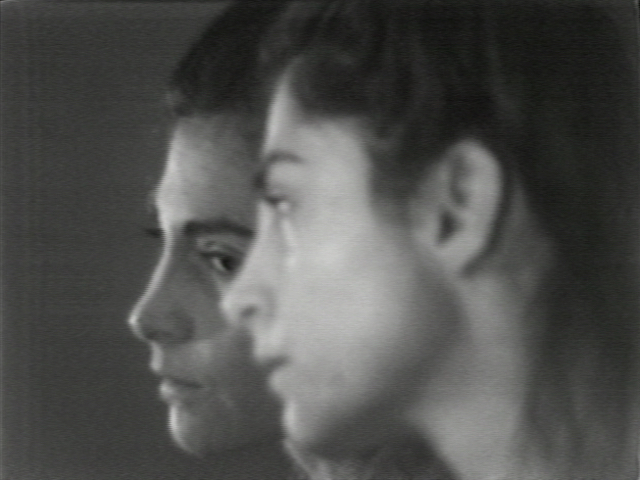Description
"In this early performance-based work, Birnbaum investigates the notion of video as a mirror to create a psychological self-portrait. Devising a simple but ingenious formal exercise, she layers real and reflected images to articulate metaphorically the duality of internal and external selves.
As the piece begins, Birnbaum appears to stand facing the camera in a medium shot. She then seems to slowly approach the camera, gazing directly at the viewer. As she advances, her image goes out of focus. Then, coming into close-up, Birnbaum appears to turn simultaneously toward and away from the camera: suddenly see her image as doubled in split. Her face, gazing at the viewer, is blurred. She turns her head slowly over her shoulder to face her reflected image. She stares into her mirrored face (which is in focus), her eyes meeting their reflection. She then turns her head to face the viewer again, before exiting the frame.
The sequence is confounding and disorienting; the viewer is at first unable to determine which image is real and which reflected or to parse the position of the artist in relation to the camera. Eventually the viewer realizes that the camera is in fact pointed at Birnbaum's reflection in a mirror. It is her reflected image that advances toward the camera, but it is her real image that comes into close-up as she passes in front of it. The artist seems to shift positions between real and reflected; in the doubled image, the viewer sees her simultaneously as subject and object of the camera's gaze.
Birnbaum repeats this sequence of actions eight times. With each iteration, she makes a slight but important shift: each time she begins, she first adjusts the focus of the camera lens. Over the course of the six-minute piece, the mirrored image increasingly goes out of focus while her real image increasingly comes in focus. By the final iteration, Birnbaum has brought her real self into sharp focus while her reflected self is now completely blurred.
Mirroring and the layering of real and reflected spaces as a metaphoric device recur in multiple forms throughout Birnbaum's work. In Technology/Transformation: Wonder Woman:(1978-79), to cite one famous example, the superhero confronts herself in a hall of mirrors. Birnbaum's first use of the motif in Mirroring presents a female subject with a direct and confident address to the camera; she projects a serene glamour that prefigures the woman gazing in introspection at her reflected image in the 1985 Will-o'-Wisp." (LZ)
Text reprinted with permission from Dara Birnbaum: The Dark Matter of Media Light. Karen J.Kelly, Barbara Schröder, and Giel Vandecaveye. Ghent/Porto/Munich: Stedelijk Museum voor Actuele Kunst/Museu Serralves/Del Monico Books-Prestel, 2011. p. 170.
